Nursing Assignment: Perianaesthesia Management of Trauma Cases
VerifiedAdded on 2022/09/22
|10
|2459
|24
Report
AI Summary
This nursing assignment report centers on the perianaesthesia management of a 32-year-old patient, Andrei Cruz, who sustained multiple injuries in a motor vehicle accident, including a compound fracture of the right distal femur, facial trauma, and seat belt syndrome. The report delves into the critical aspects of perianaesthesia care, emphasizing the importance of pre-operative assessments, including pain management, airway management, and the evaluation of potential complications such as pulmonary contusion and fractured ribs. The report highlights the nurse's role in providing airway management, ensuring breathing and circulation, and conducting disability and exposure assessments to ensure optimal patient outcomes. The case study underscores the necessity of a comprehensive approach to care, integrating knowledge of physiology and pathophysiology to manage complex patient needs effectively, and providing a detailed plan for interventions to be performed by the nurse, including pre-oxygenation, endotracheal intubation and assessment of the patient to determine the level of disability and exposure of the patient to risks.
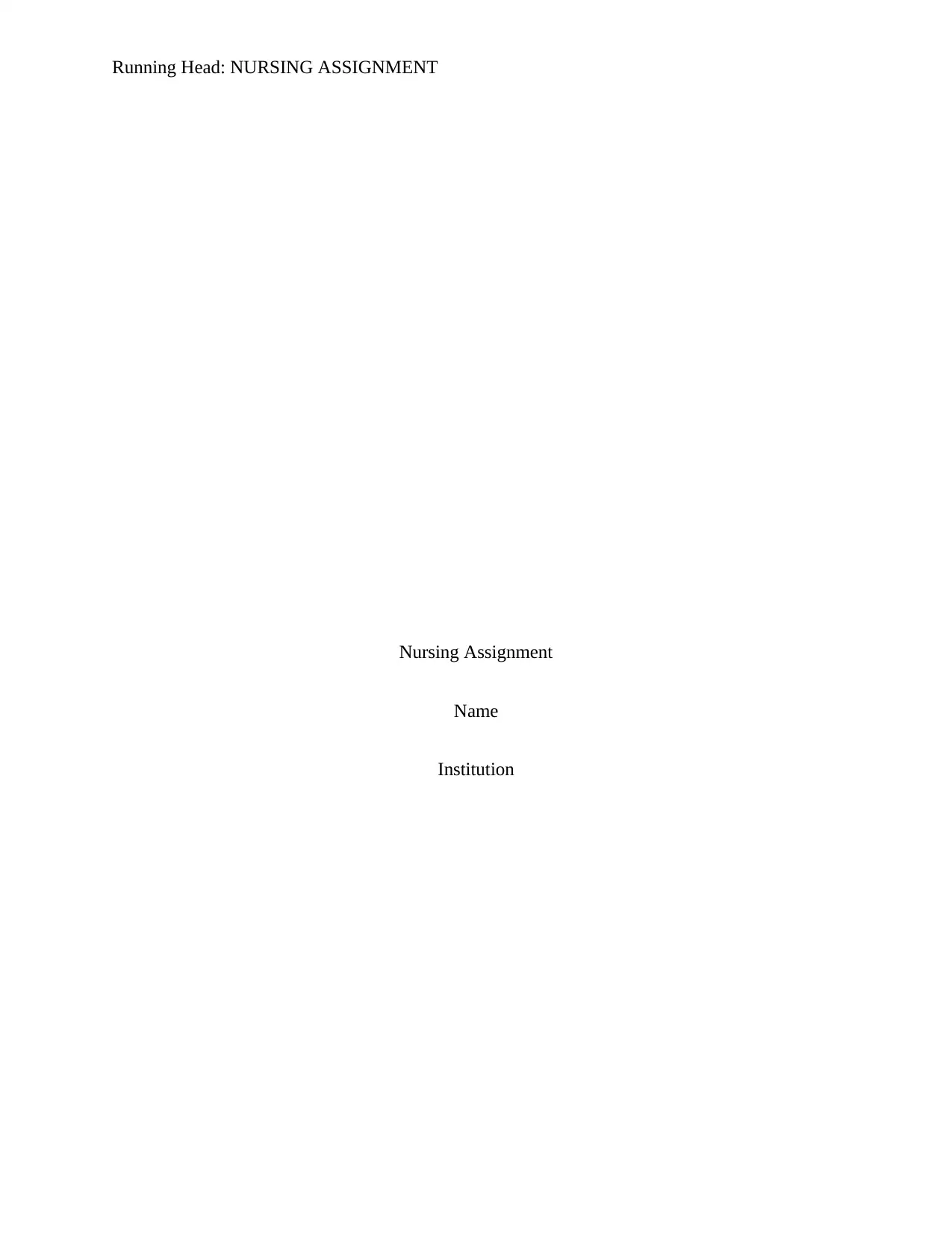
Running Head: NURSING ASSIGNMENT
Nursing Assignment
Name
Institution
Nursing Assignment
Name
Institution
Paraphrase This Document
Need a fresh take? Get an instant paraphrase of this document with our AI Paraphraser
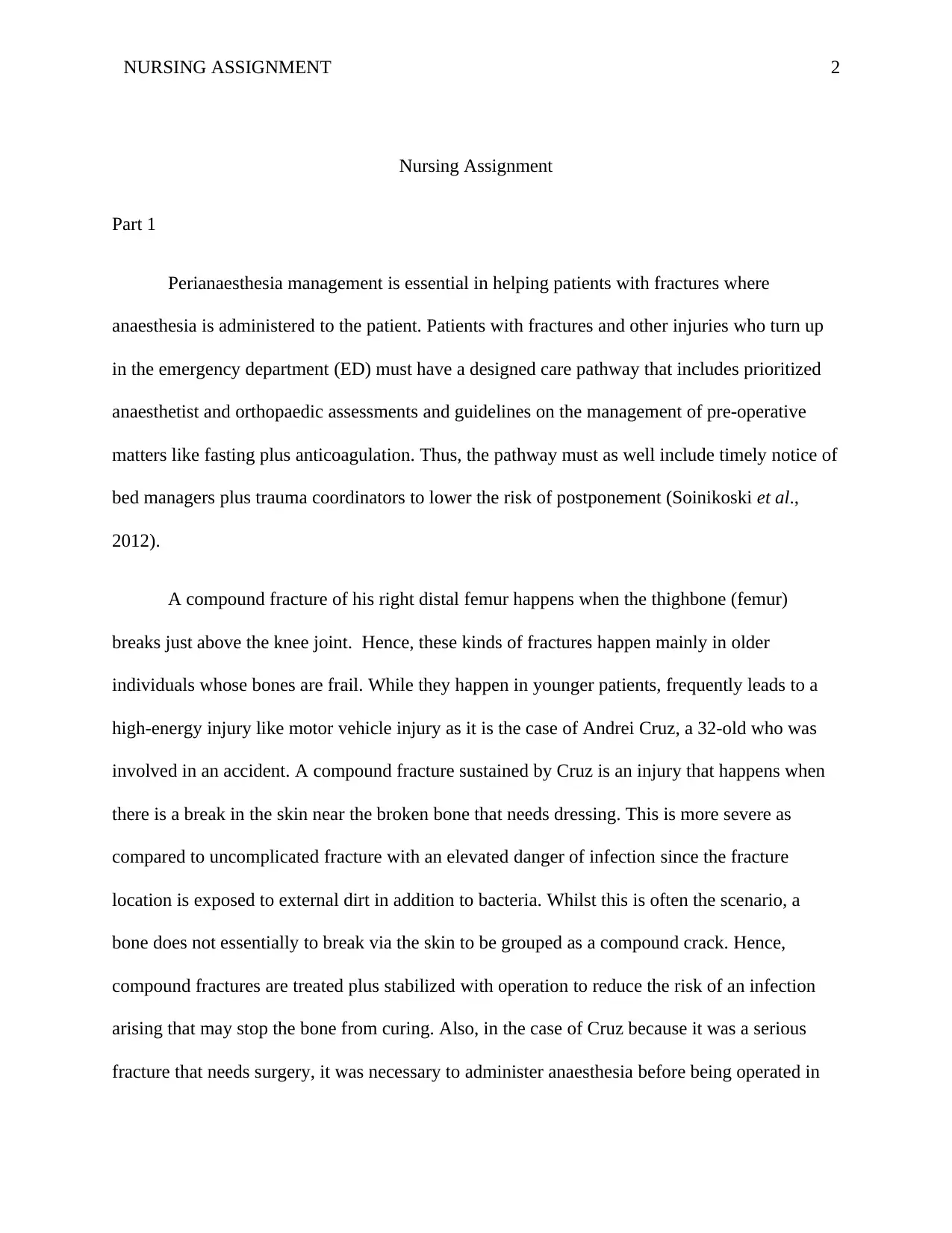
NURSING ASSIGNMENT 2
Nursing Assignment
Part 1
Perianaesthesia management is essential in helping patients with fractures where
anaesthesia is administered to the patient. Patients with fractures and other injuries who turn up
in the emergency department (ED) must have a designed care pathway that includes prioritized
anaesthetist and orthopaedic assessments and guidelines on the management of pre-operative
matters like fasting plus anticoagulation. Thus, the pathway must as well include timely notice of
bed managers plus trauma coordinators to lower the risk of postponement (Soinikoski et al.,
2012).
A compound fracture of his right distal femur happens when the thighbone (femur)
breaks just above the knee joint. Hence, these kinds of fractures happen mainly in older
individuals whose bones are frail. While they happen in younger patients, frequently leads to a
high-energy injury like motor vehicle injury as it is the case of Andrei Cruz, a 32-old who was
involved in an accident. A compound fracture sustained by Cruz is an injury that happens when
there is a break in the skin near the broken bone that needs dressing. This is more severe as
compared to uncomplicated fracture with an elevated danger of infection since the fracture
location is exposed to external dirt in addition to bacteria. Whilst this is often the scenario, a
bone does not essentially to break via the skin to be grouped as a compound crack. Hence,
compound fractures are treated plus stabilized with operation to reduce the risk of an infection
arising that may stop the bone from curing. Also, in the case of Cruz because it was a serious
fracture that needs surgery, it was necessary to administer anaesthesia before being operated in
Nursing Assignment
Part 1
Perianaesthesia management is essential in helping patients with fractures where
anaesthesia is administered to the patient. Patients with fractures and other injuries who turn up
in the emergency department (ED) must have a designed care pathway that includes prioritized
anaesthetist and orthopaedic assessments and guidelines on the management of pre-operative
matters like fasting plus anticoagulation. Thus, the pathway must as well include timely notice of
bed managers plus trauma coordinators to lower the risk of postponement (Soinikoski et al.,
2012).
A compound fracture of his right distal femur happens when the thighbone (femur)
breaks just above the knee joint. Hence, these kinds of fractures happen mainly in older
individuals whose bones are frail. While they happen in younger patients, frequently leads to a
high-energy injury like motor vehicle injury as it is the case of Andrei Cruz, a 32-old who was
involved in an accident. A compound fracture sustained by Cruz is an injury that happens when
there is a break in the skin near the broken bone that needs dressing. This is more severe as
compared to uncomplicated fracture with an elevated danger of infection since the fracture
location is exposed to external dirt in addition to bacteria. Whilst this is often the scenario, a
bone does not essentially to break via the skin to be grouped as a compound crack. Hence,
compound fractures are treated plus stabilized with operation to reduce the risk of an infection
arising that may stop the bone from curing. Also, in the case of Cruz because it was a serious
fracture that needs surgery, it was necessary to administer anaesthesia before being operated in
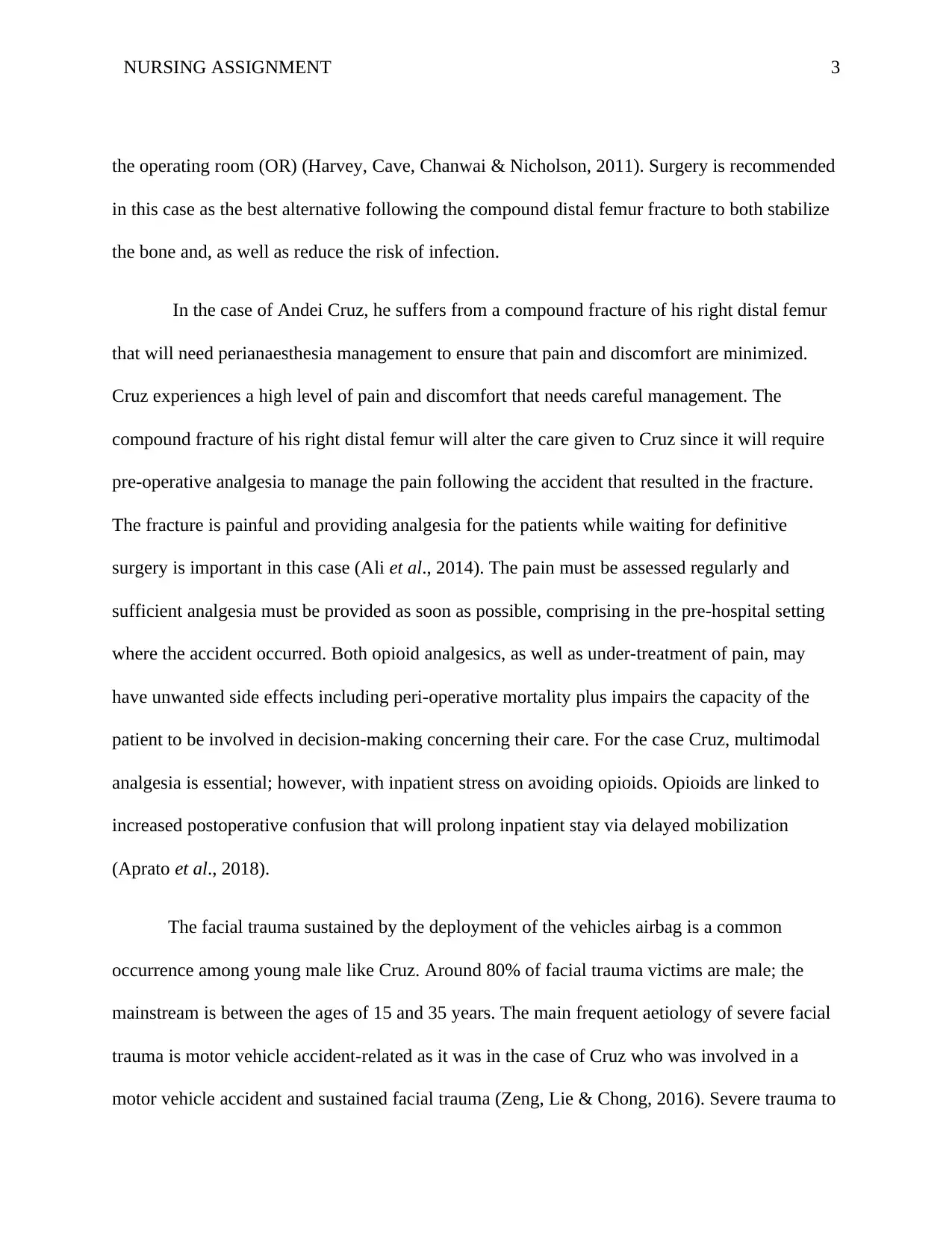
NURSING ASSIGNMENT 3
the operating room (OR) (Harvey, Cave, Chanwai & Nicholson, 2011). Surgery is recommended
in this case as the best alternative following the compound distal femur fracture to both stabilize
the bone and, as well as reduce the risk of infection.
In the case of Andei Cruz, he suffers from a compound fracture of his right distal femur
that will need perianaesthesia management to ensure that pain and discomfort are minimized.
Cruz experiences a high level of pain and discomfort that needs careful management. The
compound fracture of his right distal femur will alter the care given to Cruz since it will require
pre-operative analgesia to manage the pain following the accident that resulted in the fracture.
The fracture is painful and providing analgesia for the patients while waiting for definitive
surgery is important in this case (Ali et al., 2014). The pain must be assessed regularly and
sufficient analgesia must be provided as soon as possible, comprising in the pre-hospital setting
where the accident occurred. Both opioid analgesics, as well as under-treatment of pain, may
have unwanted side effects including peri-operative mortality plus impairs the capacity of the
patient to be involved in decision-making concerning their care. For the case Cruz, multimodal
analgesia is essential; however, with inpatient stress on avoiding opioids. Opioids are linked to
increased postoperative confusion that will prolong inpatient stay via delayed mobilization
(Aprato et al., 2018).
The facial trauma sustained by the deployment of the vehicles airbag is a common
occurrence among young male like Cruz. Around 80% of facial trauma victims are male; the
mainstream is between the ages of 15 and 35 years. The main frequent aetiology of severe facial
trauma is motor vehicle accident-related as it was in the case of Cruz who was involved in a
motor vehicle accident and sustained facial trauma (Zeng, Lie & Chong, 2016). Severe trauma to
the operating room (OR) (Harvey, Cave, Chanwai & Nicholson, 2011). Surgery is recommended
in this case as the best alternative following the compound distal femur fracture to both stabilize
the bone and, as well as reduce the risk of infection.
In the case of Andei Cruz, he suffers from a compound fracture of his right distal femur
that will need perianaesthesia management to ensure that pain and discomfort are minimized.
Cruz experiences a high level of pain and discomfort that needs careful management. The
compound fracture of his right distal femur will alter the care given to Cruz since it will require
pre-operative analgesia to manage the pain following the accident that resulted in the fracture.
The fracture is painful and providing analgesia for the patients while waiting for definitive
surgery is important in this case (Ali et al., 2014). The pain must be assessed regularly and
sufficient analgesia must be provided as soon as possible, comprising in the pre-hospital setting
where the accident occurred. Both opioid analgesics, as well as under-treatment of pain, may
have unwanted side effects including peri-operative mortality plus impairs the capacity of the
patient to be involved in decision-making concerning their care. For the case Cruz, multimodal
analgesia is essential; however, with inpatient stress on avoiding opioids. Opioids are linked to
increased postoperative confusion that will prolong inpatient stay via delayed mobilization
(Aprato et al., 2018).
The facial trauma sustained by the deployment of the vehicles airbag is a common
occurrence among young male like Cruz. Around 80% of facial trauma victims are male; the
mainstream is between the ages of 15 and 35 years. The main frequent aetiology of severe facial
trauma is motor vehicle accident-related as it was in the case of Cruz who was involved in a
motor vehicle accident and sustained facial trauma (Zeng, Lie & Chong, 2016). Severe trauma to
⊘ This is a preview!⊘
Do you want full access?
Subscribe today to unlock all pages.

Trusted by 1+ million students worldwide
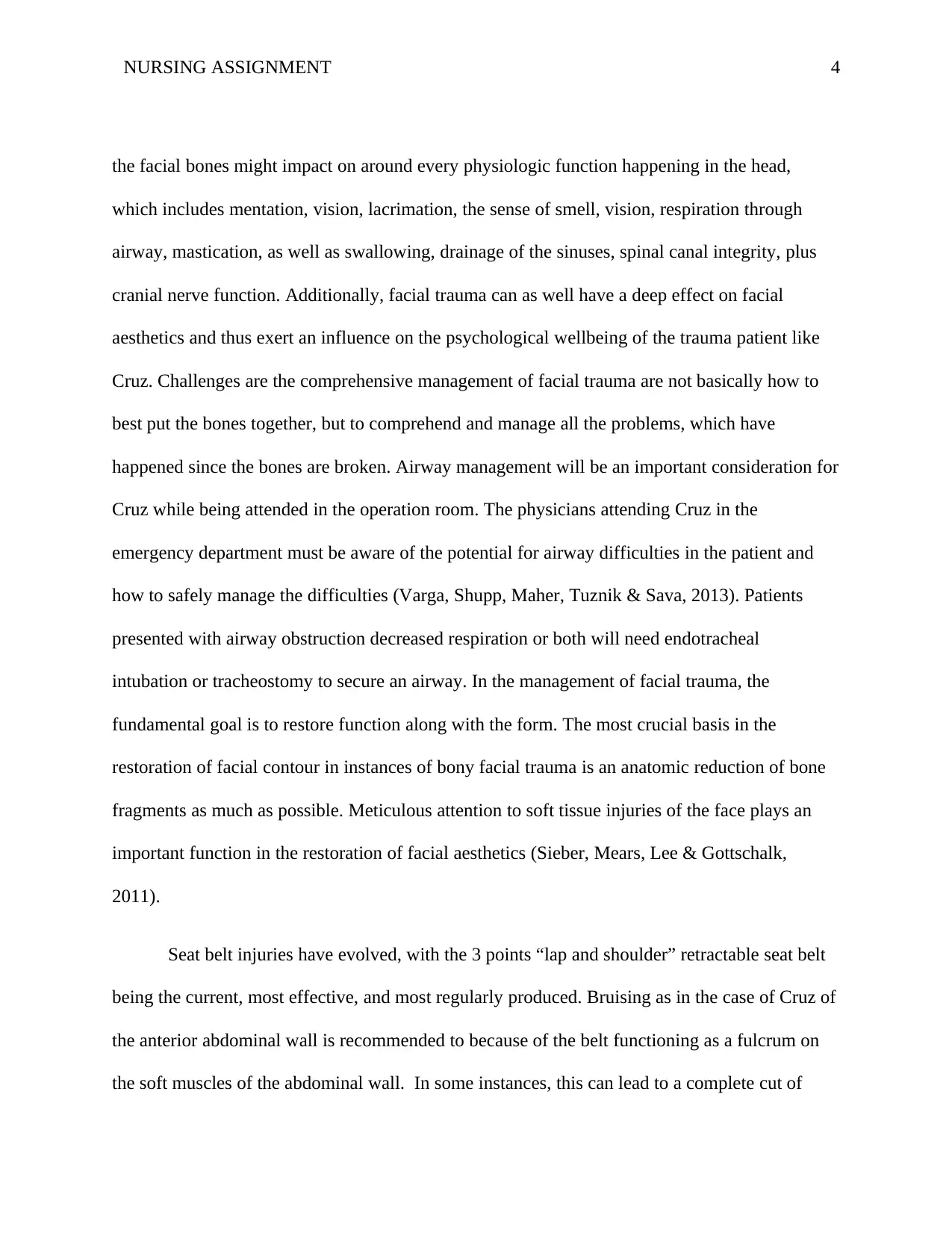
NURSING ASSIGNMENT 4
the facial bones might impact on around every physiologic function happening in the head,
which includes mentation, vision, lacrimation, the sense of smell, vision, respiration through
airway, mastication, as well as swallowing, drainage of the sinuses, spinal canal integrity, plus
cranial nerve function. Additionally, facial trauma can as well have a deep effect on facial
aesthetics and thus exert an influence on the psychological wellbeing of the trauma patient like
Cruz. Challenges are the comprehensive management of facial trauma are not basically how to
best put the bones together, but to comprehend and manage all the problems, which have
happened since the bones are broken. Airway management will be an important consideration for
Cruz while being attended in the operation room. The physicians attending Cruz in the
emergency department must be aware of the potential for airway difficulties in the patient and
how to safely manage the difficulties (Varga, Shupp, Maher, Tuznik & Sava, 2013). Patients
presented with airway obstruction decreased respiration or both will need endotracheal
intubation or tracheostomy to secure an airway. In the management of facial trauma, the
fundamental goal is to restore function along with the form. The most crucial basis in the
restoration of facial contour in instances of bony facial trauma is an anatomic reduction of bone
fragments as much as possible. Meticulous attention to soft tissue injuries of the face plays an
important function in the restoration of facial aesthetics (Sieber, Mears, Lee & Gottschalk,
2011).
Seat belt injuries have evolved, with the 3 points “lap and shoulder” retractable seat belt
being the current, most effective, and most regularly produced. Bruising as in the case of Cruz of
the anterior abdominal wall is recommended to because of the belt functioning as a fulcrum on
the soft muscles of the abdominal wall. In some instances, this can lead to a complete cut of
the facial bones might impact on around every physiologic function happening in the head,
which includes mentation, vision, lacrimation, the sense of smell, vision, respiration through
airway, mastication, as well as swallowing, drainage of the sinuses, spinal canal integrity, plus
cranial nerve function. Additionally, facial trauma can as well have a deep effect on facial
aesthetics and thus exert an influence on the psychological wellbeing of the trauma patient like
Cruz. Challenges are the comprehensive management of facial trauma are not basically how to
best put the bones together, but to comprehend and manage all the problems, which have
happened since the bones are broken. Airway management will be an important consideration for
Cruz while being attended in the operation room. The physicians attending Cruz in the
emergency department must be aware of the potential for airway difficulties in the patient and
how to safely manage the difficulties (Varga, Shupp, Maher, Tuznik & Sava, 2013). Patients
presented with airway obstruction decreased respiration or both will need endotracheal
intubation or tracheostomy to secure an airway. In the management of facial trauma, the
fundamental goal is to restore function along with the form. The most crucial basis in the
restoration of facial contour in instances of bony facial trauma is an anatomic reduction of bone
fragments as much as possible. Meticulous attention to soft tissue injuries of the face plays an
important function in the restoration of facial aesthetics (Sieber, Mears, Lee & Gottschalk,
2011).
Seat belt injuries have evolved, with the 3 points “lap and shoulder” retractable seat belt
being the current, most effective, and most regularly produced. Bruising as in the case of Cruz of
the anterior abdominal wall is recommended to because of the belt functioning as a fulcrum on
the soft muscles of the abdominal wall. In some instances, this can lead to a complete cut of
Paraphrase This Document
Need a fresh take? Get an instant paraphrase of this document with our AI Paraphraser
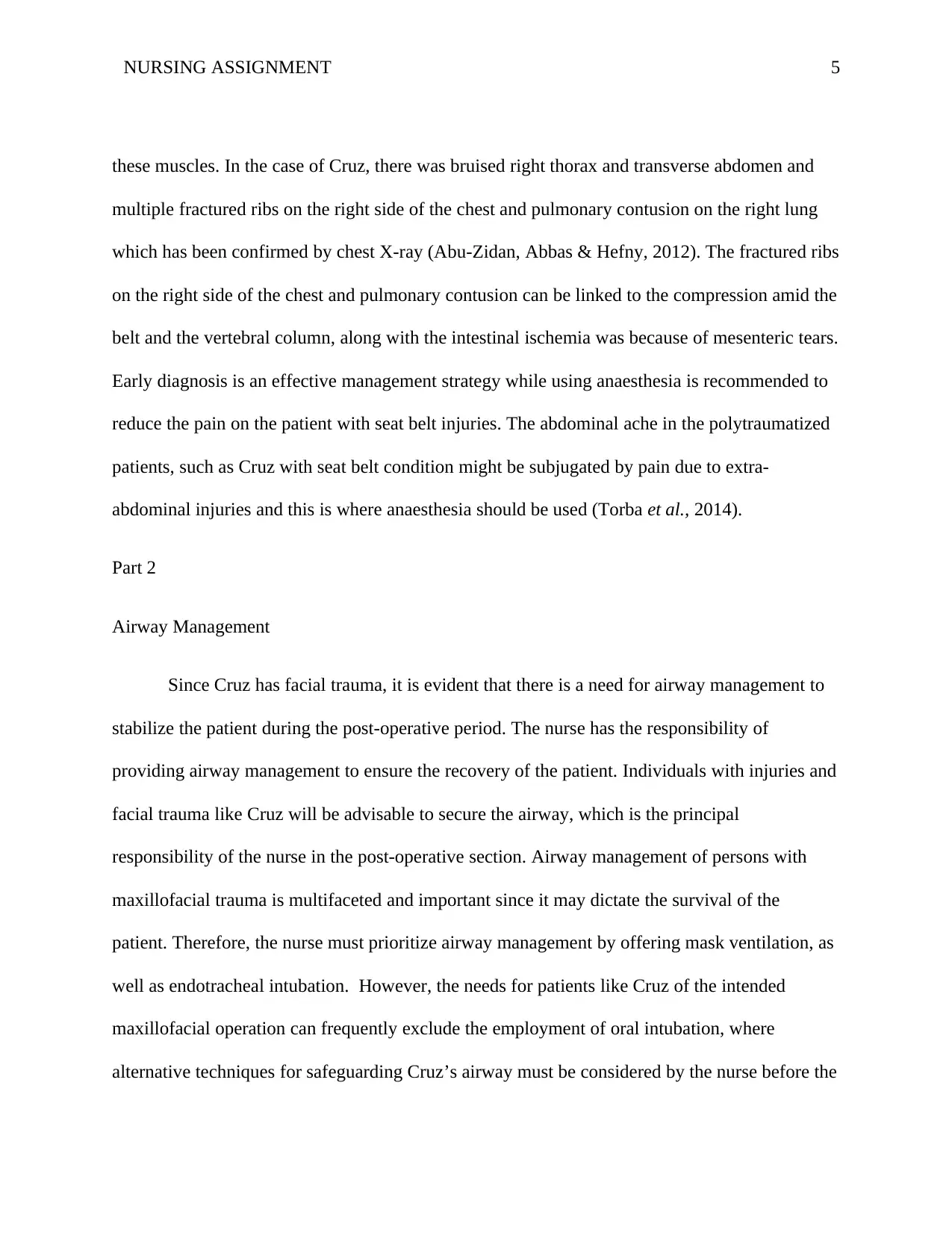
NURSING ASSIGNMENT 5
these muscles. In the case of Cruz, there was bruised right thorax and transverse abdomen and
multiple fractured ribs on the right side of the chest and pulmonary contusion on the right lung
which has been confirmed by chest X-ray (Abu-Zidan, Abbas & Hefny, 2012). The fractured ribs
on the right side of the chest and pulmonary contusion can be linked to the compression amid the
belt and the vertebral column, along with the intestinal ischemia was because of mesenteric tears.
Early diagnosis is an effective management strategy while using anaesthesia is recommended to
reduce the pain on the patient with seat belt injuries. The abdominal ache in the polytraumatized
patients, such as Cruz with seat belt condition might be subjugated by pain due to extra-
abdominal injuries and this is where anaesthesia should be used (Torba et al., 2014).
Part 2
Airway Management
Since Cruz has facial trauma, it is evident that there is a need for airway management to
stabilize the patient during the post-operative period. The nurse has the responsibility of
providing airway management to ensure the recovery of the patient. Individuals with injuries and
facial trauma like Cruz will be advisable to secure the airway, which is the principal
responsibility of the nurse in the post-operative section. Airway management of persons with
maxillofacial trauma is multifaceted and important since it may dictate the survival of the
patient. Therefore, the nurse must prioritize airway management by offering mask ventilation, as
well as endotracheal intubation. However, the needs for patients like Cruz of the intended
maxillofacial operation can frequently exclude the employment of oral intubation, where
alternative techniques for safeguarding Cruz’s airway must be considered by the nurse before the
these muscles. In the case of Cruz, there was bruised right thorax and transverse abdomen and
multiple fractured ribs on the right side of the chest and pulmonary contusion on the right lung
which has been confirmed by chest X-ray (Abu-Zidan, Abbas & Hefny, 2012). The fractured ribs
on the right side of the chest and pulmonary contusion can be linked to the compression amid the
belt and the vertebral column, along with the intestinal ischemia was because of mesenteric tears.
Early diagnosis is an effective management strategy while using anaesthesia is recommended to
reduce the pain on the patient with seat belt injuries. The abdominal ache in the polytraumatized
patients, such as Cruz with seat belt condition might be subjugated by pain due to extra-
abdominal injuries and this is where anaesthesia should be used (Torba et al., 2014).
Part 2
Airway Management
Since Cruz has facial trauma, it is evident that there is a need for airway management to
stabilize the patient during the post-operative period. The nurse has the responsibility of
providing airway management to ensure the recovery of the patient. Individuals with injuries and
facial trauma like Cruz will be advisable to secure the airway, which is the principal
responsibility of the nurse in the post-operative section. Airway management of persons with
maxillofacial trauma is multifaceted and important since it may dictate the survival of the
patient. Therefore, the nurse must prioritize airway management by offering mask ventilation, as
well as endotracheal intubation. However, the needs for patients like Cruz of the intended
maxillofacial operation can frequently exclude the employment of oral intubation, where
alternative techniques for safeguarding Cruz’s airway must be considered by the nurse before the
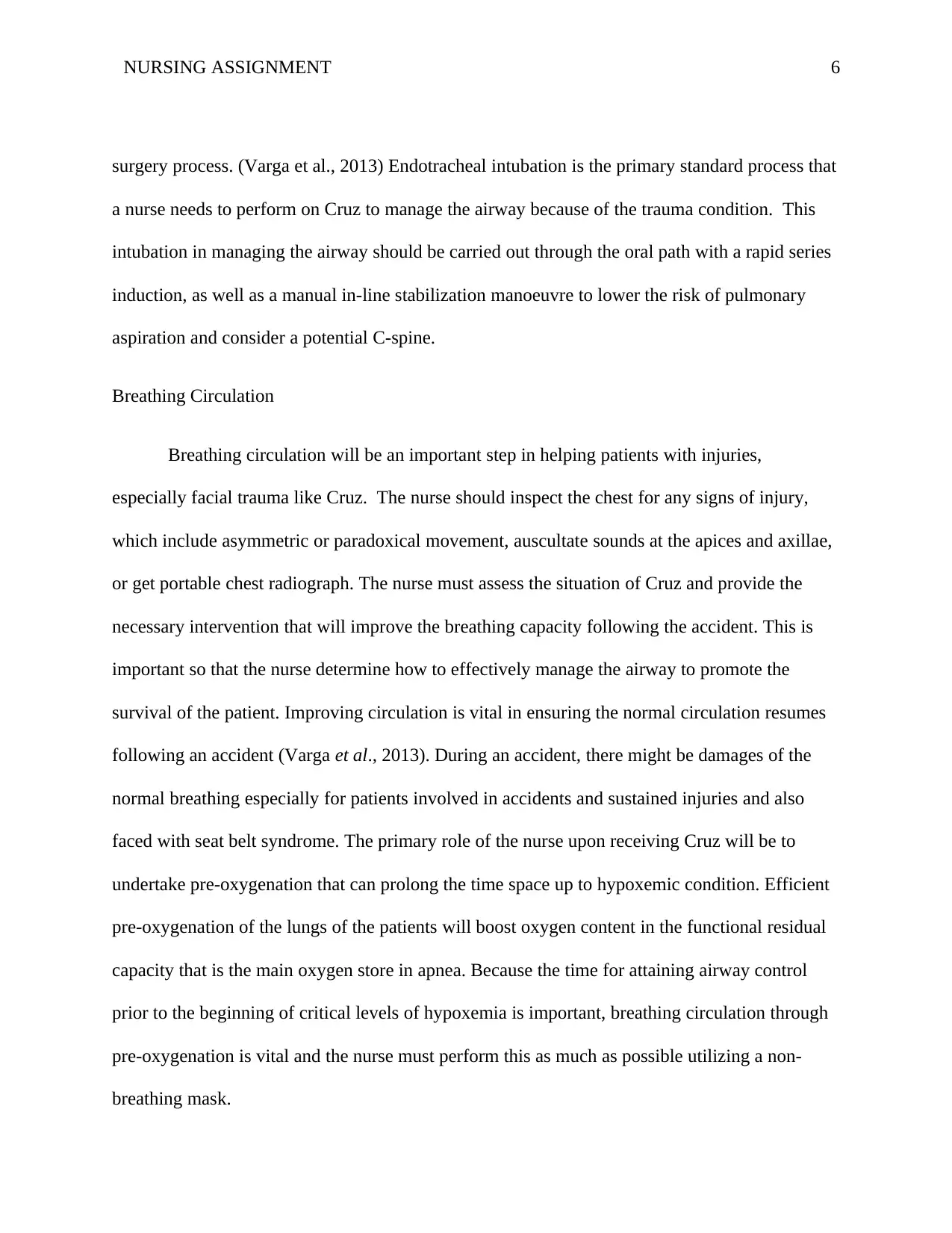
NURSING ASSIGNMENT 6
surgery process. (Varga et al., 2013) Endotracheal intubation is the primary standard process that
a nurse needs to perform on Cruz to manage the airway because of the trauma condition. This
intubation in managing the airway should be carried out through the oral path with a rapid series
induction, as well as a manual in-line stabilization manoeuvre to lower the risk of pulmonary
aspiration and consider a potential C-spine.
Breathing Circulation
Breathing circulation will be an important step in helping patients with injuries,
especially facial trauma like Cruz. The nurse should inspect the chest for any signs of injury,
which include asymmetric or paradoxical movement, auscultate sounds at the apices and axillae,
or get portable chest radiograph. The nurse must assess the situation of Cruz and provide the
necessary intervention that will improve the breathing capacity following the accident. This is
important so that the nurse determine how to effectively manage the airway to promote the
survival of the patient. Improving circulation is vital in ensuring the normal circulation resumes
following an accident (Varga et al., 2013). During an accident, there might be damages of the
normal breathing especially for patients involved in accidents and sustained injuries and also
faced with seat belt syndrome. The primary role of the nurse upon receiving Cruz will be to
undertake pre-oxygenation that can prolong the time space up to hypoxemic condition. Efficient
pre-oxygenation of the lungs of the patients will boost oxygen content in the functional residual
capacity that is the main oxygen store in apnea. Because the time for attaining airway control
prior to the beginning of critical levels of hypoxemia is important, breathing circulation through
pre-oxygenation is vital and the nurse must perform this as much as possible utilizing a non-
breathing mask.
surgery process. (Varga et al., 2013) Endotracheal intubation is the primary standard process that
a nurse needs to perform on Cruz to manage the airway because of the trauma condition. This
intubation in managing the airway should be carried out through the oral path with a rapid series
induction, as well as a manual in-line stabilization manoeuvre to lower the risk of pulmonary
aspiration and consider a potential C-spine.
Breathing Circulation
Breathing circulation will be an important step in helping patients with injuries,
especially facial trauma like Cruz. The nurse should inspect the chest for any signs of injury,
which include asymmetric or paradoxical movement, auscultate sounds at the apices and axillae,
or get portable chest radiograph. The nurse must assess the situation of Cruz and provide the
necessary intervention that will improve the breathing capacity following the accident. This is
important so that the nurse determine how to effectively manage the airway to promote the
survival of the patient. Improving circulation is vital in ensuring the normal circulation resumes
following an accident (Varga et al., 2013). During an accident, there might be damages of the
normal breathing especially for patients involved in accidents and sustained injuries and also
faced with seat belt syndrome. The primary role of the nurse upon receiving Cruz will be to
undertake pre-oxygenation that can prolong the time space up to hypoxemic condition. Efficient
pre-oxygenation of the lungs of the patients will boost oxygen content in the functional residual
capacity that is the main oxygen store in apnea. Because the time for attaining airway control
prior to the beginning of critical levels of hypoxemia is important, breathing circulation through
pre-oxygenation is vital and the nurse must perform this as much as possible utilizing a non-
breathing mask.
⊘ This is a preview!⊘
Do you want full access?
Subscribe today to unlock all pages.

Trusted by 1+ million students worldwide
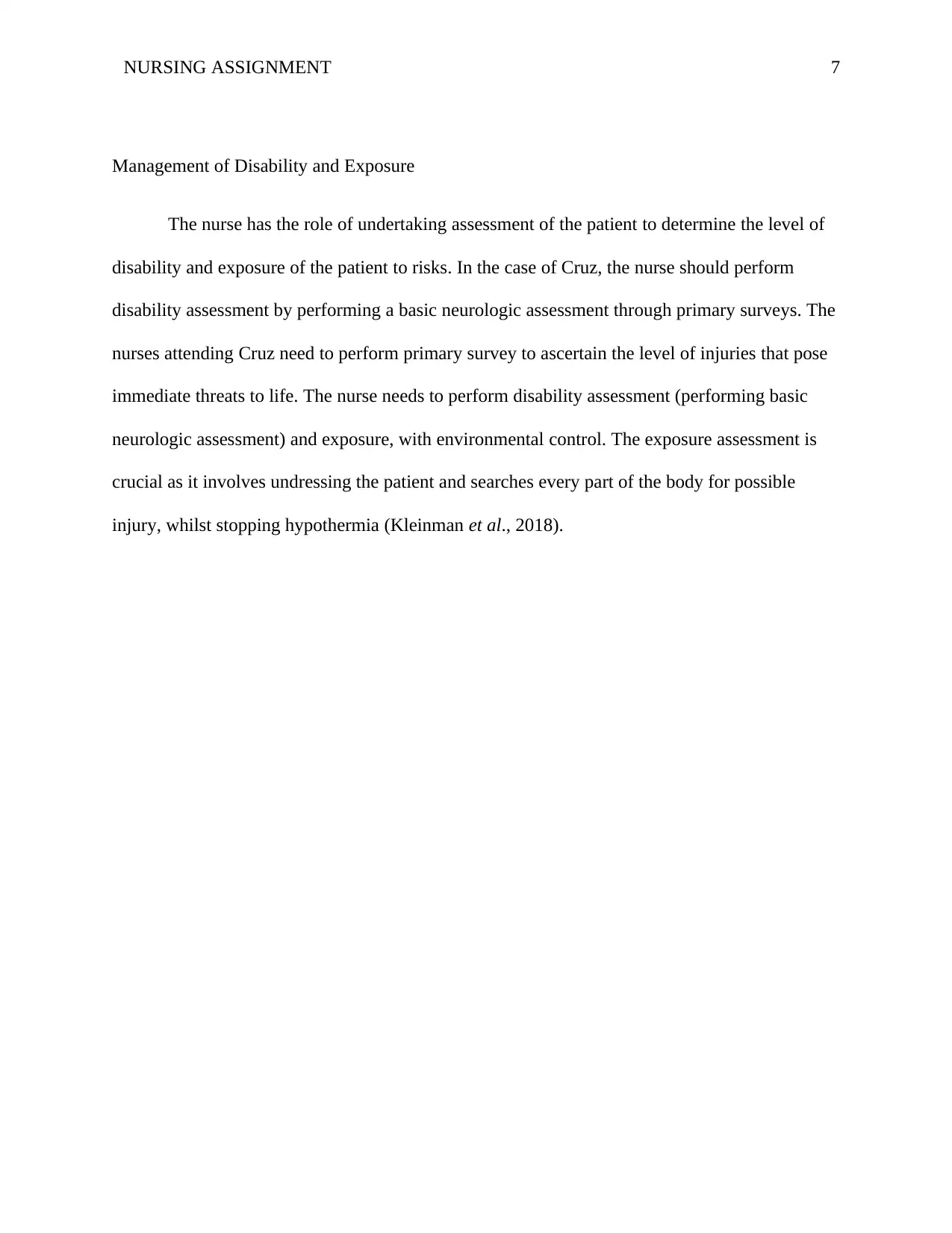
NURSING ASSIGNMENT 7
Management of Disability and Exposure
The nurse has the role of undertaking assessment of the patient to determine the level of
disability and exposure of the patient to risks. In the case of Cruz, the nurse should perform
disability assessment by performing a basic neurologic assessment through primary surveys. The
nurses attending Cruz need to perform primary survey to ascertain the level of injuries that pose
immediate threats to life. The nurse needs to perform disability assessment (performing basic
neurologic assessment) and exposure, with environmental control. The exposure assessment is
crucial as it involves undressing the patient and searches every part of the body for possible
injury, whilst stopping hypothermia (Kleinman et al., 2018).
Management of Disability and Exposure
The nurse has the role of undertaking assessment of the patient to determine the level of
disability and exposure of the patient to risks. In the case of Cruz, the nurse should perform
disability assessment by performing a basic neurologic assessment through primary surveys. The
nurses attending Cruz need to perform primary survey to ascertain the level of injuries that pose
immediate threats to life. The nurse needs to perform disability assessment (performing basic
neurologic assessment) and exposure, with environmental control. The exposure assessment is
crucial as it involves undressing the patient and searches every part of the body for possible
injury, whilst stopping hypothermia (Kleinman et al., 2018).
Paraphrase This Document
Need a fresh take? Get an instant paraphrase of this document with our AI Paraphraser
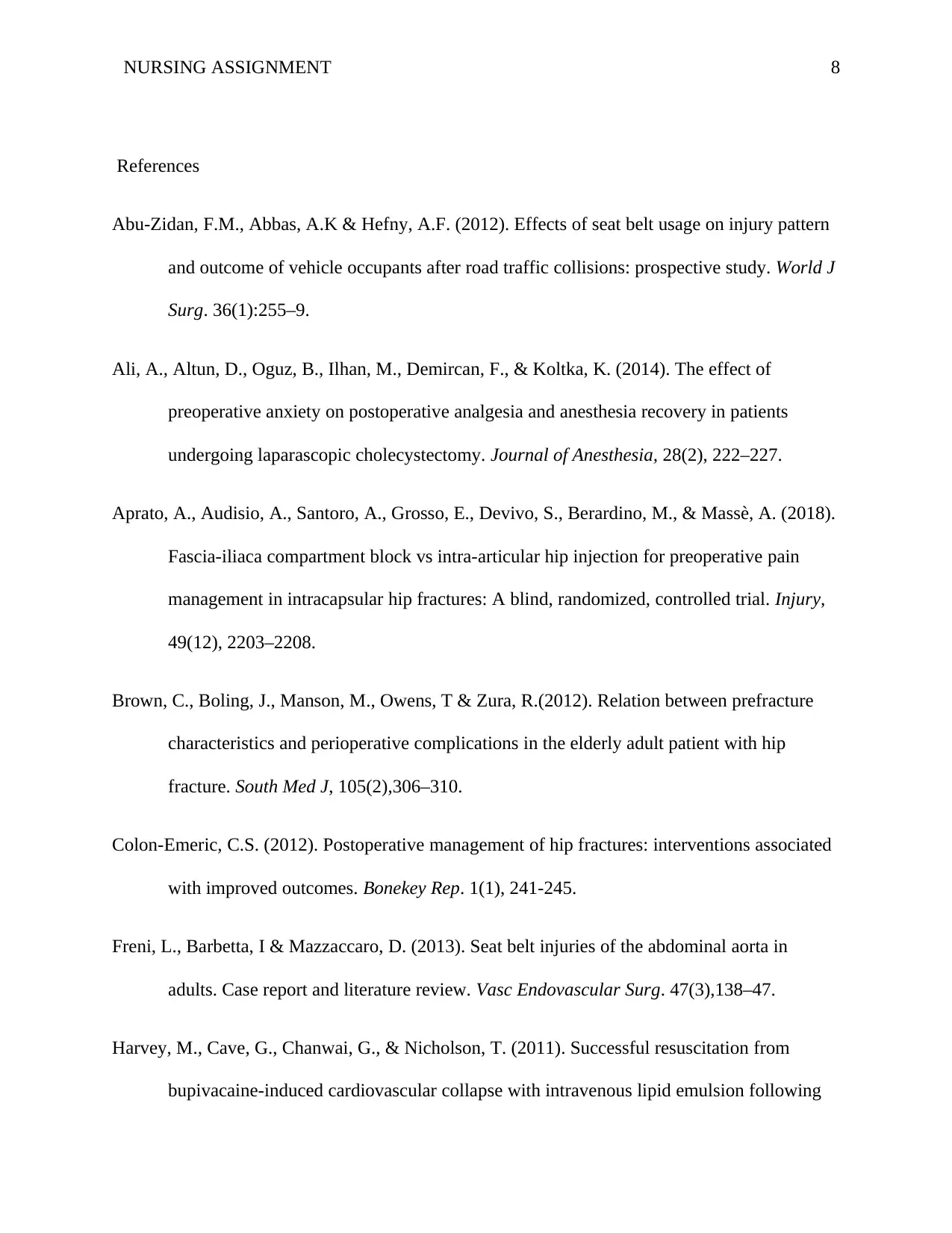
NURSING ASSIGNMENT 8
References
Abu-Zidan, F.M., Abbas, A.K & Hefny, A.F. (2012). Effects of seat belt usage on injury pattern
and outcome of vehicle occupants after road traffic collisions: prospective study. World J
Surg. 36(1):255–9.
Ali, A., Altun, D., Oguz, B., Ilhan, M., Demircan, F., & Koltka, K. (2014). The effect of
preoperative anxiety on postoperative analgesia and anesthesia recovery in patients
undergoing laparascopic cholecystectomy. Journal of Anesthesia, 28(2), 222–227.
Aprato, A., Audisio, A., Santoro, A., Grosso, E., Devivo, S., Berardino, M., & Massè, A. (2018).
Fascia-iliaca compartment block vs intra-articular hip injection for preoperative pain
management in intracapsular hip fractures: A blind, randomized, controlled trial. Injury,
49(12), 2203–2208.
Brown, C., Boling, J., Manson, M., Owens, T & Zura, R.(2012). Relation between prefracture
characteristics and perioperative complications in the elderly adult patient with hip
fracture. South Med J, 105(2),306–310.
Colon-Emeric, C.S. (2012). Postoperative management of hip fractures: interventions associated
with improved outcomes. Bonekey Rep. 1(1), 241-245.
Freni, L., Barbetta, I & Mazzaccaro, D. (2013). Seat belt injuries of the abdominal aorta in
adults. Case report and literature review. Vasc Endovascular Surg. 47(3),138–47.
Harvey, M., Cave, G., Chanwai, G., & Nicholson, T. (2011). Successful resuscitation from
bupivacaine-induced cardiovascular collapse with intravenous lipid emulsion following
References
Abu-Zidan, F.M., Abbas, A.K & Hefny, A.F. (2012). Effects of seat belt usage on injury pattern
and outcome of vehicle occupants after road traffic collisions: prospective study. World J
Surg. 36(1):255–9.
Ali, A., Altun, D., Oguz, B., Ilhan, M., Demircan, F., & Koltka, K. (2014). The effect of
preoperative anxiety on postoperative analgesia and anesthesia recovery in patients
undergoing laparascopic cholecystectomy. Journal of Anesthesia, 28(2), 222–227.
Aprato, A., Audisio, A., Santoro, A., Grosso, E., Devivo, S., Berardino, M., & Massè, A. (2018).
Fascia-iliaca compartment block vs intra-articular hip injection for preoperative pain
management in intracapsular hip fractures: A blind, randomized, controlled trial. Injury,
49(12), 2203–2208.
Brown, C., Boling, J., Manson, M., Owens, T & Zura, R.(2012). Relation between prefracture
characteristics and perioperative complications in the elderly adult patient with hip
fracture. South Med J, 105(2),306–310.
Colon-Emeric, C.S. (2012). Postoperative management of hip fractures: interventions associated
with improved outcomes. Bonekey Rep. 1(1), 241-245.
Freni, L., Barbetta, I & Mazzaccaro, D. (2013). Seat belt injuries of the abdominal aorta in
adults. Case report and literature review. Vasc Endovascular Surg. 47(3),138–47.
Harvey, M., Cave, G., Chanwai, G., & Nicholson, T. (2011). Successful resuscitation from
bupivacaine-induced cardiovascular collapse with intravenous lipid emulsion following
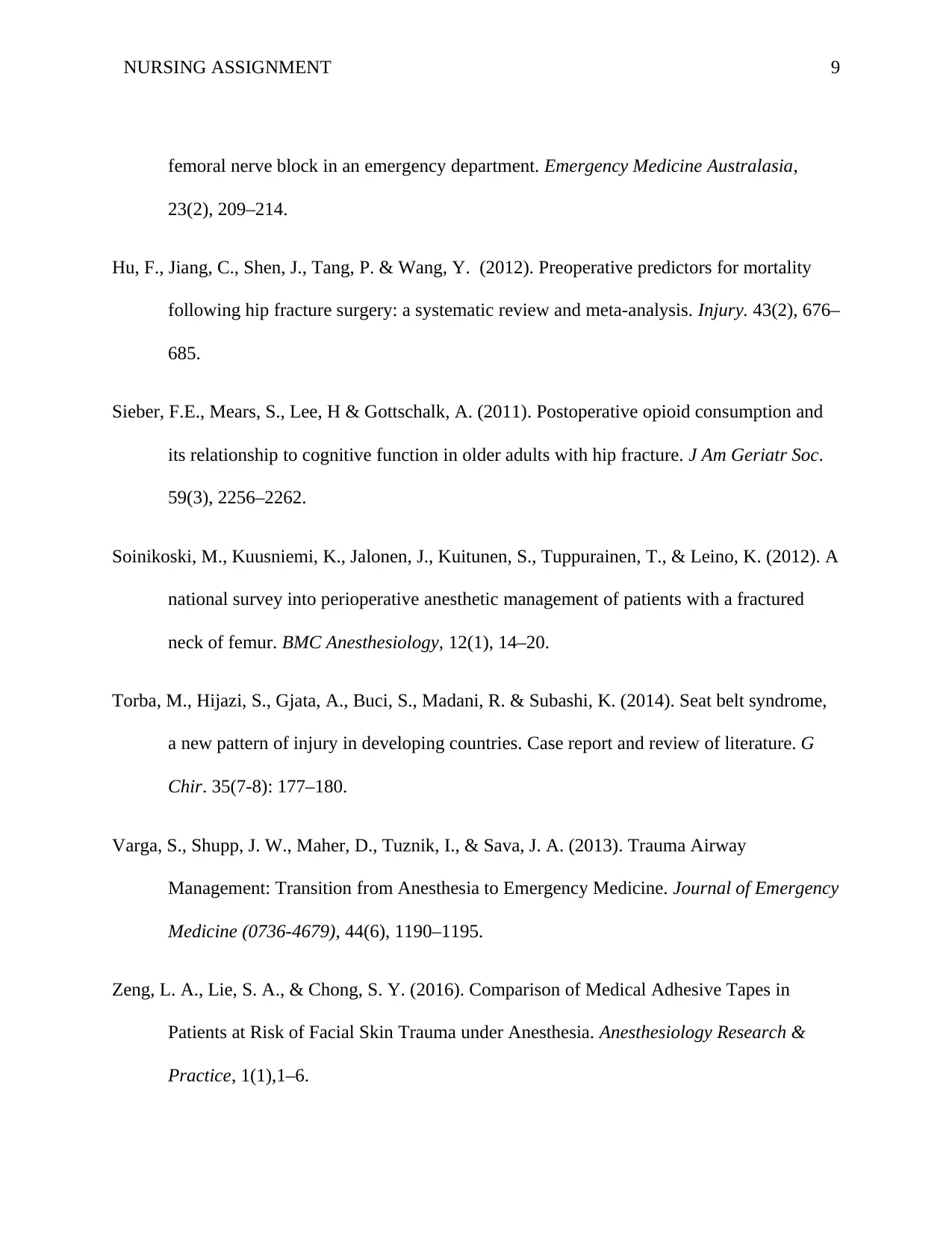
NURSING ASSIGNMENT 9
femoral nerve block in an emergency department. Emergency Medicine Australasia,
23(2), 209–214.
Hu, F., Jiang, C., Shen, J., Tang, P. & Wang, Y. (2012). Preoperative predictors for mortality
following hip fracture surgery: a systematic review and meta-analysis. Injury. 43(2), 676–
685.
Sieber, F.E., Mears, S., Lee, H & Gottschalk, A. (2011). Postoperative opioid consumption and
its relationship to cognitive function in older adults with hip fracture. J Am Geriatr Soc.
59(3), 2256–2262.
Soinikoski, M., Kuusniemi, K., Jalonen, J., Kuitunen, S., Tuppurainen, T., & Leino, K. (2012). A
national survey into perioperative anesthetic management of patients with a fractured
neck of femur. BMC Anesthesiology, 12(1), 14–20.
Torba, M., Hijazi, S., Gjata, A., Buci, S., Madani, R. & Subashi, K. (2014). Seat belt syndrome,
a new pattern of injury in developing countries. Case report and review of literature. G
Chir. 35(7-8): 177–180.
Varga, S., Shupp, J. W., Maher, D., Tuznik, I., & Sava, J. A. (2013). Trauma Airway
Management: Transition from Anesthesia to Emergency Medicine. Journal of Emergency
Medicine (0736-4679), 44(6), 1190–1195.
Zeng, L. A., Lie, S. A., & Chong, S. Y. (2016). Comparison of Medical Adhesive Tapes in
Patients at Risk of Facial Skin Trauma under Anesthesia. Anesthesiology Research &
Practice, 1(1),1–6.
femoral nerve block in an emergency department. Emergency Medicine Australasia,
23(2), 209–214.
Hu, F., Jiang, C., Shen, J., Tang, P. & Wang, Y. (2012). Preoperative predictors for mortality
following hip fracture surgery: a systematic review and meta-analysis. Injury. 43(2), 676–
685.
Sieber, F.E., Mears, S., Lee, H & Gottschalk, A. (2011). Postoperative opioid consumption and
its relationship to cognitive function in older adults with hip fracture. J Am Geriatr Soc.
59(3), 2256–2262.
Soinikoski, M., Kuusniemi, K., Jalonen, J., Kuitunen, S., Tuppurainen, T., & Leino, K. (2012). A
national survey into perioperative anesthetic management of patients with a fractured
neck of femur. BMC Anesthesiology, 12(1), 14–20.
Torba, M., Hijazi, S., Gjata, A., Buci, S., Madani, R. & Subashi, K. (2014). Seat belt syndrome,
a new pattern of injury in developing countries. Case report and review of literature. G
Chir. 35(7-8): 177–180.
Varga, S., Shupp, J. W., Maher, D., Tuznik, I., & Sava, J. A. (2013). Trauma Airway
Management: Transition from Anesthesia to Emergency Medicine. Journal of Emergency
Medicine (0736-4679), 44(6), 1190–1195.
Zeng, L. A., Lie, S. A., & Chong, S. Y. (2016). Comparison of Medical Adhesive Tapes in
Patients at Risk of Facial Skin Trauma under Anesthesia. Anesthesiology Research &
Practice, 1(1),1–6.
⊘ This is a preview!⊘
Do you want full access?
Subscribe today to unlock all pages.

Trusted by 1+ million students worldwide

NURSING ASSIGNMENT 10
Kleinman, J., Inaba, K., Pott, E., Matsushima, K., Demetriades, D & Strumwasser .A. (2018),
Early FAST Examinations during Resuscitation May Compromise Trauma
Outcomes. Am Surg. 84(10):1705-1709.
Kleinman, J., Inaba, K., Pott, E., Matsushima, K., Demetriades, D & Strumwasser .A. (2018),
Early FAST Examinations during Resuscitation May Compromise Trauma
Outcomes. Am Surg. 84(10):1705-1709.
1 out of 10
Related Documents
Your All-in-One AI-Powered Toolkit for Academic Success.
+13062052269
info@desklib.com
Available 24*7 on WhatsApp / Email
![[object Object]](/_next/static/media/star-bottom.7253800d.svg)
Unlock your academic potential
Copyright © 2020–2025 A2Z Services. All Rights Reserved. Developed and managed by ZUCOL.





